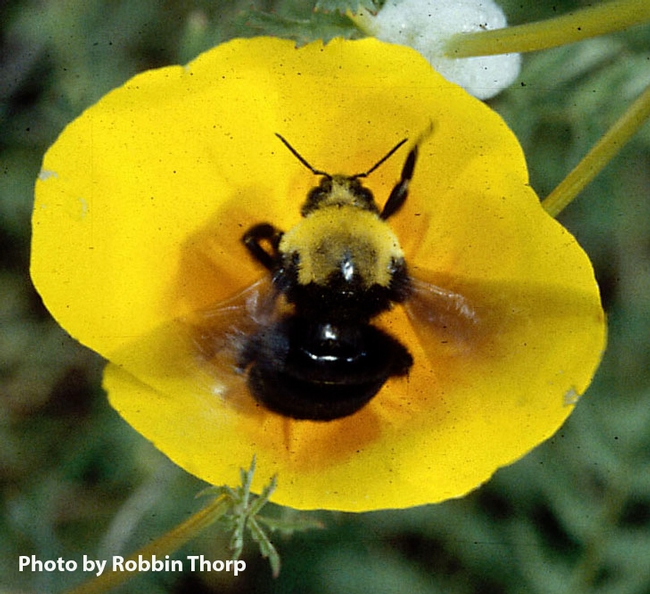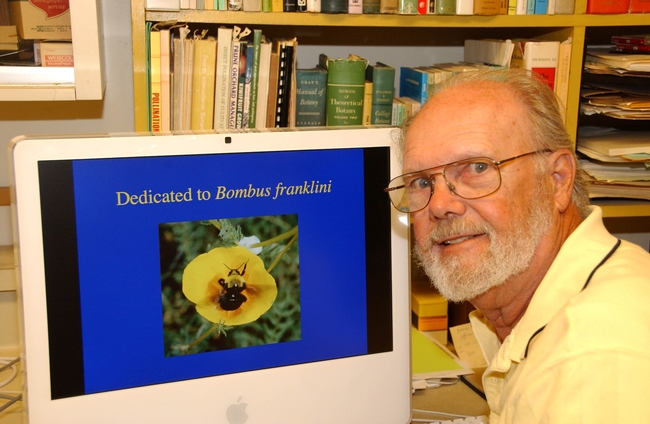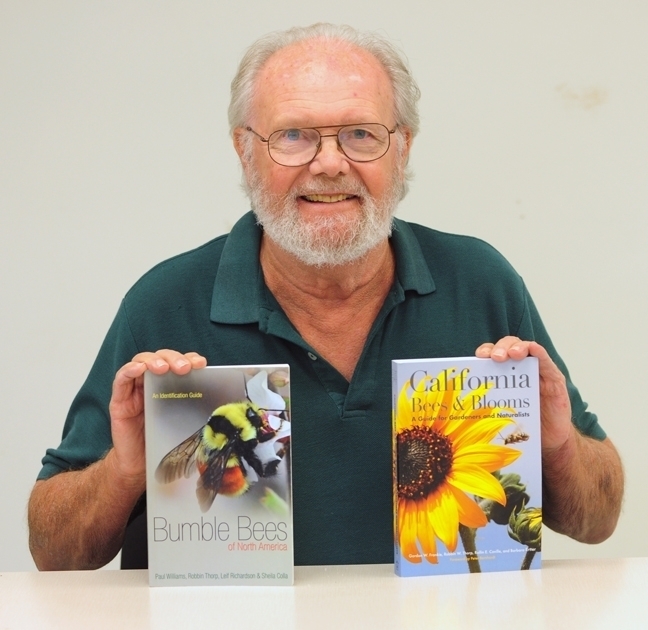
Franklin's bumble bee, Bombus franklini,--a bee that he monitored for decades until his death in 2019--is now protected as an endangered species under the Endangered Species Act (ESA). Protection means opening up funding and resources.
The U.S. Fish and Wildlife Service (FWS) announced its decision Aug. 23 to place the bumble bee, known to inhabit only a small range of southern Oregon and northern California real estate, on the Endangered Species List. Only one other bumble bee, the rusty patched bumble bee, Bombus affinis, is on that list.
Thorp, the last known person to see Franklin's bumble bee in its native habitat, spotted it in 2006 near Mt. Ashland. The bee inhabits--or did--a 13,300-square-mile area confined to five counties--Siskiyou and Trinity counties in California; and Jackson, Douglas and Josephine counties in Oregon. Its range may be the smallest range of any bumble bee species in North America, or even the world, he mused.
Thorp, a member of the UC Davis entomology faculty for 30 years (1964-1994), continued his research, teaching and public service until his death in 2019 at age 85. He was known for his expertise, dedication and passion in protecting native pollinators, especially bumble bees, and for his teaching, research and public service. A worldwide expert on bumble bees, he co-authored the landmark Bumble Bees of North America: an Identification Guide, published in 2014.
The UC Davis scientist especially zeroed in on Franklin's bumble bee. Knowing it was critically imperiled, he and the Xerces Society for Invertebrate Conservation petitioned FWS in 2010 for its endangered species status. In June 2019, just before he died, he was delighted to hear it had made the "proposed list" of endangered species.
Gaining endangered species status could not only lead to its recovery, Thorp told us, but would also help us "better understand environmental threats to pollinators and how to prevent them in future." He called the petition "a wake-up call to the importance of pollinators and the need to provide protections from the various threats to the health of their populations.”
Many Trips to Hunt for the Bee
We recounted his many trips to the five-county area to search for the elusive bumble bee, and his never-fading optimism.
“I am still hopeful that Franklin's bumble bee is still out there somewhere,” Thorp told us in a news article published in 2011. “Over the last 13 years I have watched the populations of this bumble bee decline precipitously. My hope is this species can recover before it is too late."
Thorp's surveys, conducted since 1998, clearly showed the declining population. His Franklin's bumble bee sightings decreased from 94 in 1998 to 20 in 1999 to 9 in 2000 to one in 2001. Sightings increased slightly to 20 in 2002, but dropped to three in 2003. Thorp saw none in 2004 and 2005; one in 2006; and none since.
“Even though none have been seen since 2006, Franklin's bumble bee populations could potentially persist undetected,” FWS wrote in a news release. The bee is listed as endangered, but its habitat is not. Why? “Because the bee is considered to be flexible with regards to its habitat, the availability of habitat does not limit the conservation of the Franklin's bumble bee now, nor will it in the foreseeable future," a FWS spokesperson said.
Named in 1921 for Henry J. Franklin (who monographed the bumble bees of North and South America in 1912-13), Franklin's bumble bee was known to frequent California poppies, lupines, vetch, wild roses, blackberries, clover, sweet peas, horsemint and mountain penny royal during its flight season, from mid-May through September. The bumble bee "collects pollen, primarily from lupines and poppies, and gathers nectar mainly from mints," Thorp told us.
Thorp's determined hunt for the bumble bee resulted in the CNN publication of "The Old Man and the Bee," a spin-off of Hemingway's "The Old Man and the Sea."
Thorp liked the headline, but he told us he was just hoping that the bee itself would make headlines. He wanted it found.
The next best thing, however, is that the Fish and Wildlife Service has "found" Franklin's bumble bee and it is now protected.
(Editor's note: See more information on the Federal Register.)
Attached Images:

The late Robbin Thorp, UC Davis distinguished emeritus professor, kept his image of Franklin's bumble bee as his screensaver image on his computer. He last saw the bee in 2006 at Mt. Ashland, and was the last known person to see the pollinator. (Photo by Kathy Keatley Garvey)

Robbin Thorp, an expert on pollinators, including bumble bees, co-authored these two books in 2014. (Photo by Kathy Keatley Garvey)